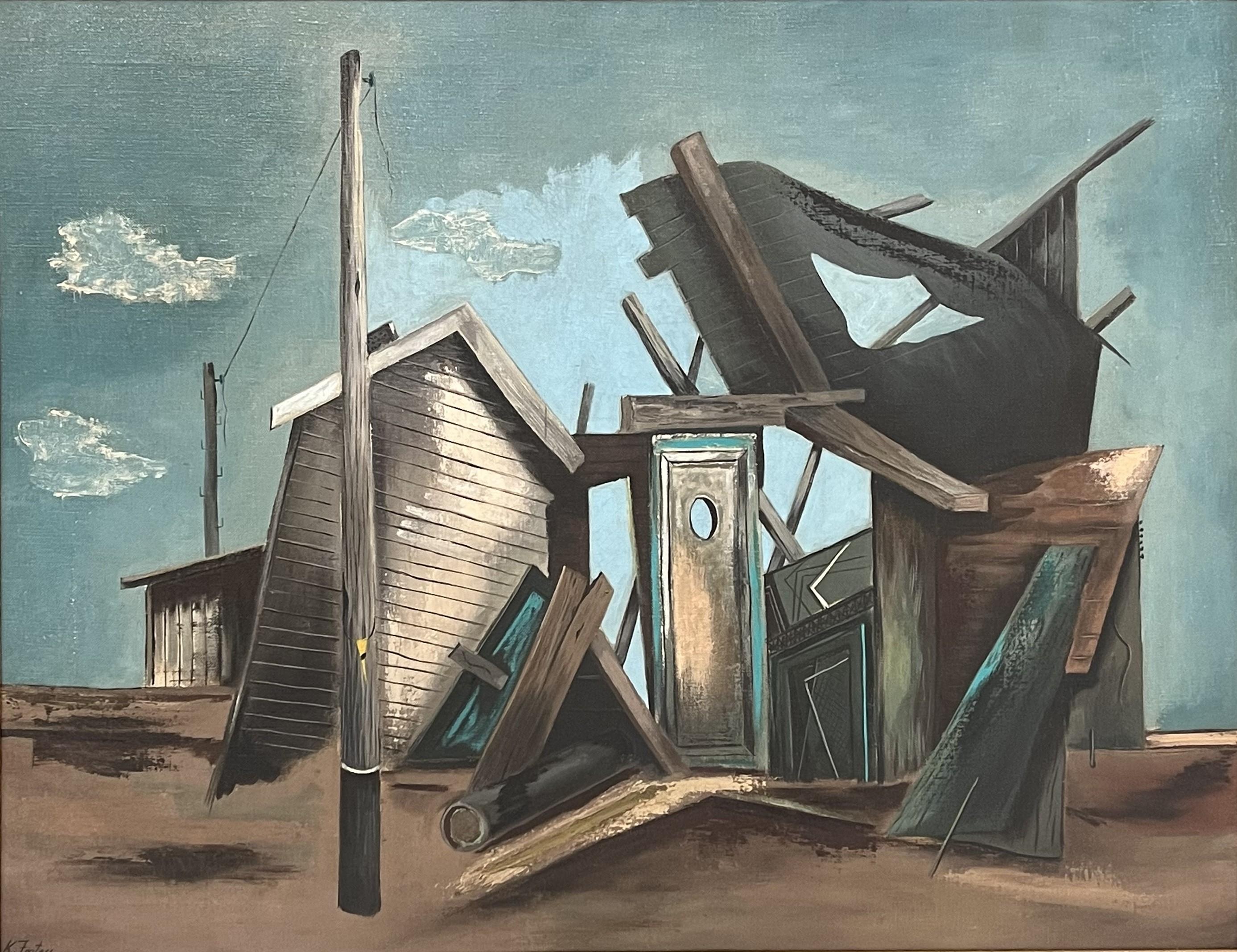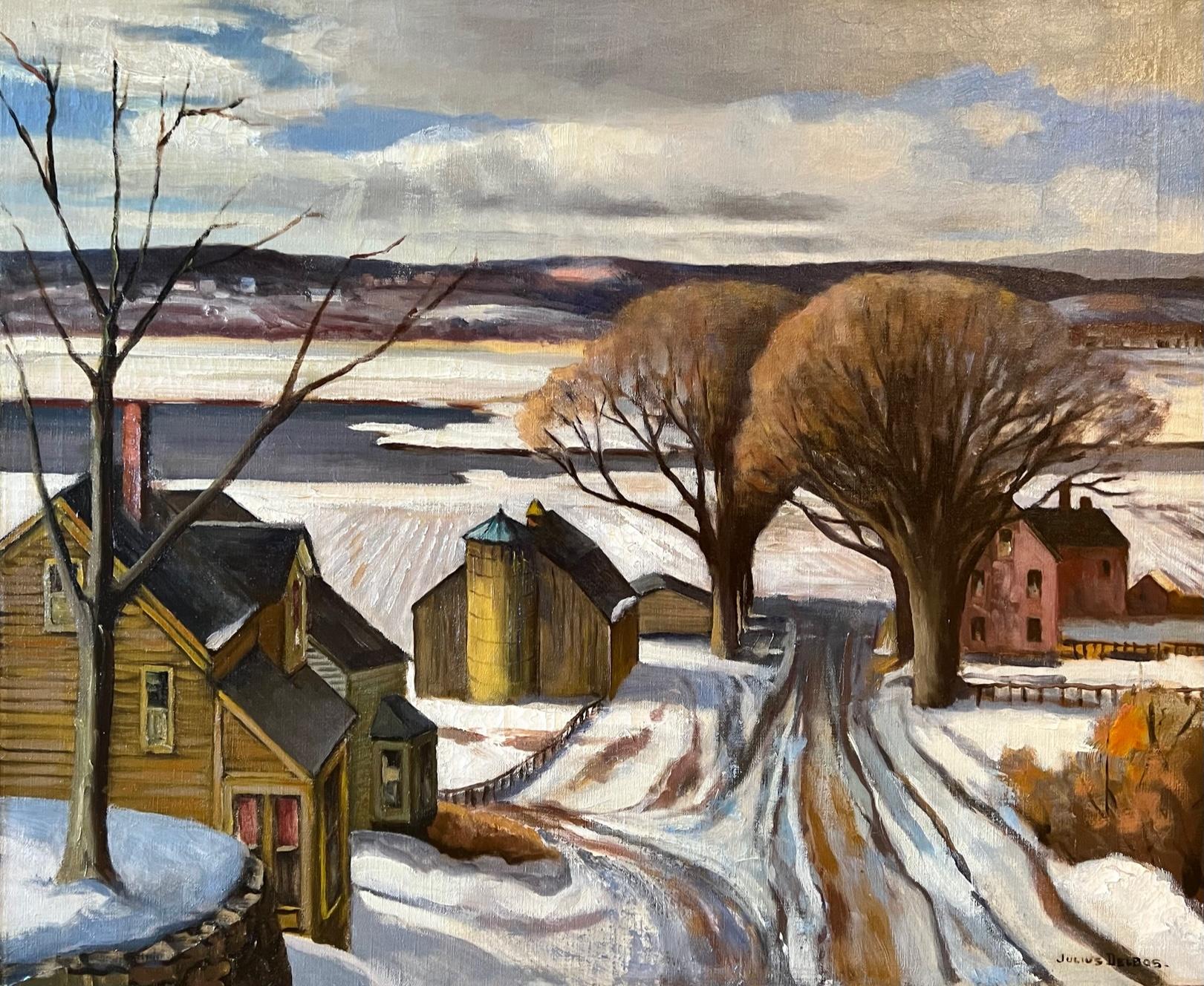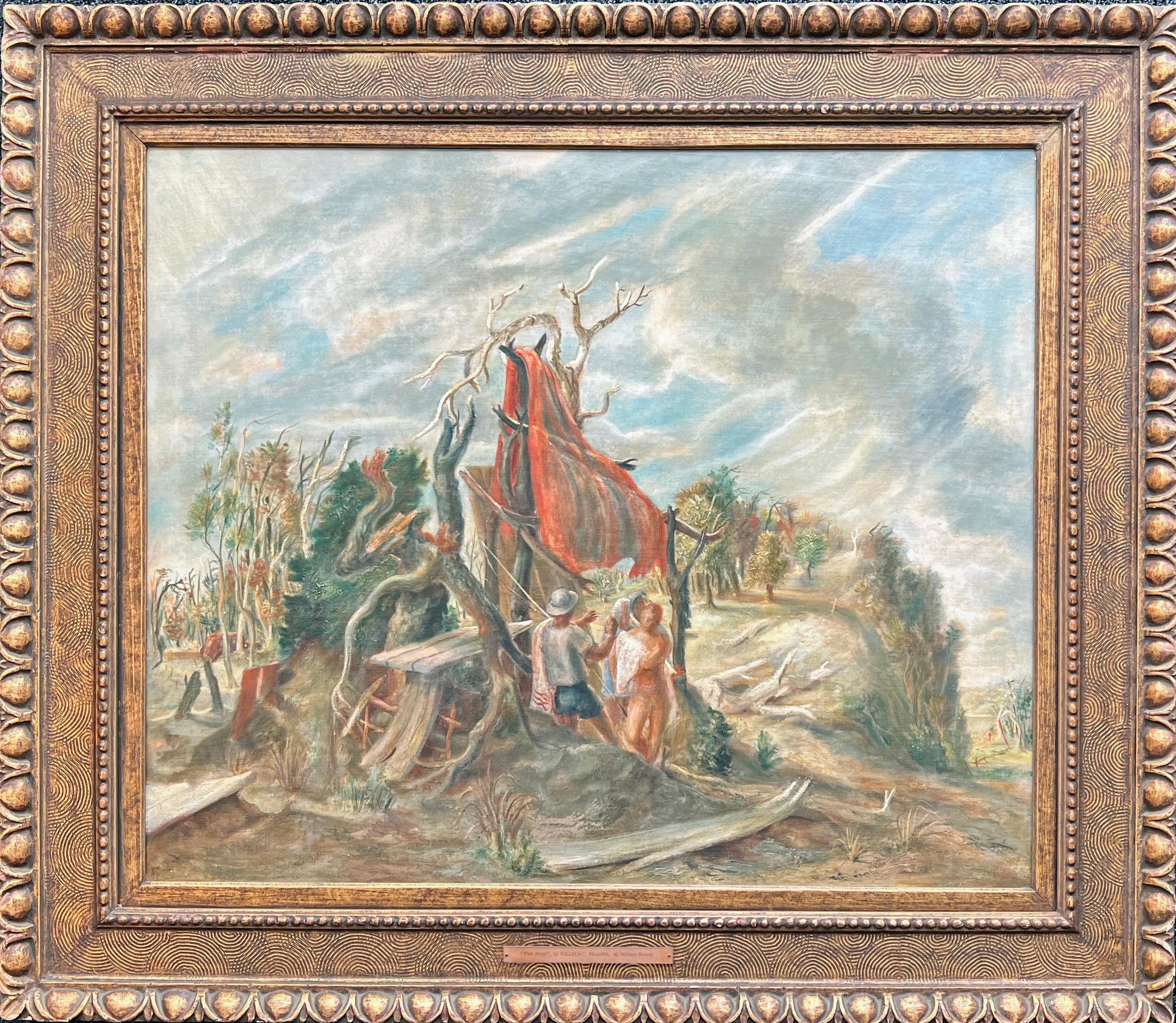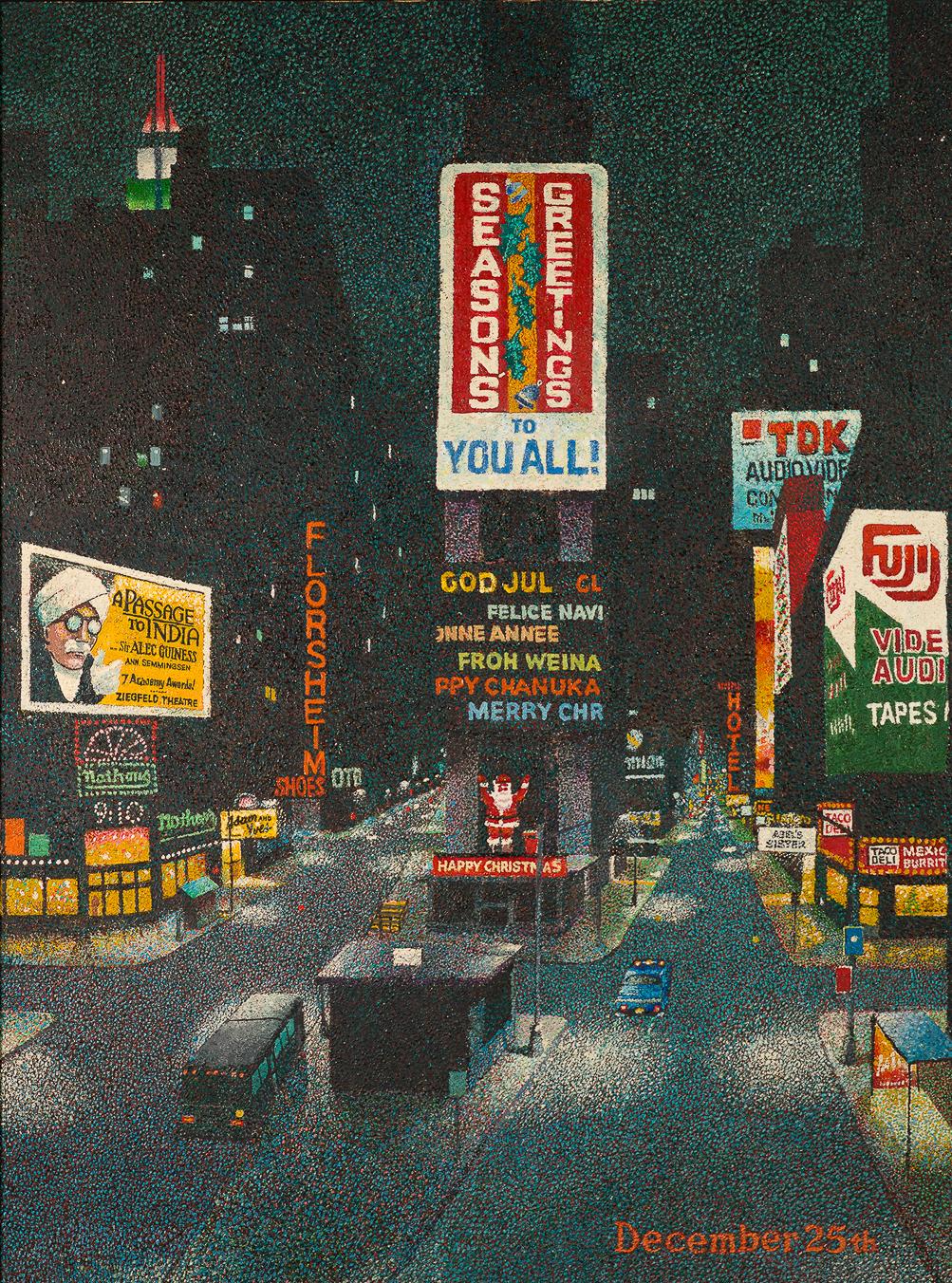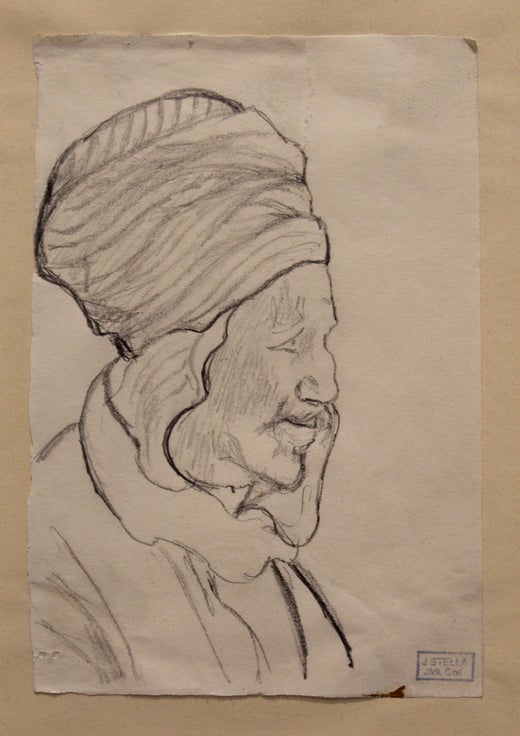Joseph Stella"Study of Mt. Vesuvius" Oil on Canvas, Blue Tones, Landscape1915 - 1920
1915 - 1920
About the Item
- Creator:Joseph Stella (1877-1946, American, Italian)
- Creation Year:1915 - 1920
- Dimensions:Height: 16.5 in (41.91 cm)Width: 19.5 in (49.53 cm)
- Medium:
- Movement & Style:
- Period:
- Condition:
- Gallery Location:Detroit, MI
- Reference Number:1stDibs: LU128616729202
Joseph Stella
Joseph Stella was a visionary artist who painted what he saw, an idiosyncratic and individual experience of his time and place. Stella arrived in New York in 1896, part of a wave of Italian immigrants from poverty-stricken Southern Italy. But Stella was not a child of poverty. His father was a notary and respected citizen in Muro Lucano, a small town in the southern Apennines. The five Stella brothers were all properly educated in Naples. Stella’s older brother, Antonio, was the first of the family to come to America. Antonio Stella trained as a physician in Italy, and was a successful and respected doctor in the Italian community centered in Greenwich Village. He sponsored and supported his younger brother, Joseph, first sending him to medical school in New York, then to study pharmacology, and then sustaining him through the early days of his artistic career. Antonio Stella specialized in the treatment of tuberculosis and was active in social reform circles. His connections were instrumental in Joseph Stella’s early commissions for illustrations in reform journals.
Joseph Stella, from the beginning, was an outsider. He was of the Italian-American community, but did not share its overwhelming poverty and general lack of education. He went back to Italy on several occasions, but was no longer an Italian. His art incorporated many influences. At various times his work echoed the concerns and techniques of the so-called Ashcan School, of New York Dada, of Futurism and, of Cubism, among others. These are all legitimate influences, but Stella never totally committed himself to any group. He was a convivial, but ultimately solitary figure, with a lifelong mistrust of any authority external to his own personal mandate. He was in Europe during the time that Alfred Stieglitz established his 291 Gallery. When Stella returned he joined the international coterie of artists who gathered at the West Side apartment of the art patron Conrad Arensberg. It was here that Stella became close friends with Marcel Duchamp.
Stella was 19 when he arrived in America and studied in the early years of the century at the Art Students League, and with William Merritt Chase, under whose tutelage he received rigorous training as a draftsman. His love of line, and his mastery of its techniques, is apparent early in his career in the illustrations he made for various social reform journals. Stella, whose later work as a colorist is breathtakingly lush, never felt obliged to choose between line and color. He drew throughout his career, and unlike other modernists, whose work evolved inexorably to more and more abstract form, Stella freely reverted to earlier realist modes of representation whenever it suited him. This was because, in fact, his “realist” work was not “true to nature,” but true to Stella’s own unique interpretation. Stella began to draw flowers, vegetables, butterflies, and birds in 1919, after he had finished the Brooklyn Bridge series of paintings, which are probably his best-known works. These drawings of flora and fauna were initially coincidental with his fantastical, nostalgic and spiritual vision of his native Italy which he called Tree of My Life (Mr. and Mrs. Barney A. Ebsworth Foundation and Windsor, Inc., St. Louis, illus. in Barbara Haskell, Joseph Stella, exh. cat. [New York: Whitney Museum of American Art, 1994], p. 111 no. 133).
(Biography provided by Hirschl & Adler)
- ShippingRetrieving quote...Ships From: Detroit, MI
- Return PolicyA return for this item may be initiated within 14 days of delivery.
- Guy Maccoy "City Beyond the Bluffs" Cityscape Oil on Board MCMLocated in Detroit, MISALE ONE WEEK ONLY "City Beyond the Bluffs" is a colorful dynamic example of Maccoy's Mid-20th century paintings. Considered Mid-Century Modern it also has Cubist style in the bluffs. Unframed the piece measures 25 x 42. Guy Crittington McKay was born to Clifford McKay and Clara Angeline Young who was the granddaughter of Brigham Young. Clifford McKay later changed the family name to McCoy. Later on Guy changed his name to Maccoy. Guy Maccoy...Category
Mid-20th Century American Modern Landscape Paintings
MaterialsOil, Board
- Thom O'Connor Pastel on Paper "The Model #5"By Thom O'ConnorLocated in Detroit, MI"The Model #5" is a pastel on paper showing a nude female figure emerging from what appears to be an evening darkening mist where a distant landscape is suggested or perhaps she is e...Category
Late 20th Century American Modern Figurative Paintings
MaterialsPastel, Paper
- Helmut Gransow Landscape w/House & Barn "Springtime Reflections No. I"Located in Detroit, MISALE ONE WEEK ONLY “Springtown Reflections No. I” depicts the moment of change in the weather moving from harsh winter to the first warming days of spring melting the snow. The title suggests a moment to pause in farm life before the coming spring planting and also suggests a time of mental reflection on life and work. The puddles of melting snow reflect the buildings in the scene. The muted colors and slightly off kilter structures cause the buildings to appear worn but sturdy, a soft idyllic scene of rural life. Helmut Gransow...Category
1970s Modern Landscape Paintings
MaterialsOil, Linen
- Henry Wallace Methven "Impressionist Landscape" Water, Trees Summer ReflectionLocated in Detroit, MISALE ONE WEEK ONLY Impressionist Landscape" is an exquisitely peaceful late summer scene along the banks of a quiet river. The dappling yellow and green leaves and the spots of blue sky give the perfect impressionistic feel to the scene. Impressionism was a style or movement in painting originating in France in the 1860s, characterized by a concern with depicting the visual impression of the moment, especially in terms of the shifting effect of light and color. Methven captured this impression perfectly. It is as fresh today as when it was painted in 1902 so much so that you can almost hear the rustle of the leaves and see the shifting light. The gold gilt frame is original to the piece. Without the frame the piece measures 20 h x 16 w. It is signed by the artist. Methven was born in Philadelphia, Pennsylvania. In the 1930's he moved to Chicago, Illinois, where he painted with other area Chicago artists and showed at The Art Institute of Chicago. He spent his summers in Benton Harbor, Michigan, along Lake Michigan. He is known for his landscapes and water scenes. Michigan has numerous rivers, creeks and small lakes and Methven would have had a wealth of scenes to draw upon for his numerous oil paintings. He studied under Henry Fenton Spread who taught at the School of the Art Institute of Chicago and later founded Spread's Art Academy. In 1902, this academy became the Chicago Academy of Fine Arts. Spread was named the first president of the Chicago Society of Artists in 1889. Known primarily as a portraitist, Spread also painted landscape and genre scenes. Although a skilled artist, he did not exhibit widely; his primary legacy being fostering a love of art in Chicago. Fellow artist (and former student of Spread), Ralph Clarkson, the noted Chicago society portrait painter, stated that Spread' s "fine and advice formed the careers of the men who were not only to achieve prominence as artists, but to occupy leading places as art teachers". Harry Wallace Methven...Category
Early 1900s Impressionist Landscape Paintings
MaterialsCanvas, Oil
- Thomas M Nicholas Winter Country Scene Northeast OilLocated in Detroit, MISALE ONE WEEK ONLY The untitled oil painting of a quiet country winter scene is a typical subject matter for T. M. Nicholas who is considered by many to be among the most prominent painter of his generation and specifically of the Rockport School of Art. Painting is signed in the lower right front corner. He grew up admiring the rugged beauty of the U.S. northeast coastline especially the landscapes of coastal New England. His father, esteemed painter, Tom Nicholas...Category
1990s Landscape Paintings
MaterialsCanvas, Oil
- "Roxbury" Massachusetts, Acrylic, Street Scene, Winner Student PrizeLocated in Detroit, MISALE ONE WEEK ONLY “Roxbury” is a stunning landscape of architecture and city deleterious. Moon-Joo Lee received her MFA from Cranbrook Academy of Art, Department of Painting in 2003 and received the schools' Top Prize with this painting. “Roxbury” subsequently was on display at Chrysler’s World Headquarters for a period of time. While at Cranbrook she began to document the ubiquitous construction sites skirting Detroit and similar cities across the country. The transitory urban fabric became her compelling subject, emblematic of fluctuating socio-economic conditions and a widespread culture of uncertainty. - Joe Houston of Cranbrook Art Museum. Lee’s painting “Roxbury” captures the cycle of construction, destruction and reconstruction that perpetually transforms the American city scene. In this image, a business that boasts NEW in its signage is already in the process of being destroyed. This could be a scene of bombing or environmental damage, but per Moon-Joo Lee’s aesthetics, the mountainous terrain of assorted refuse is there to remind the viewer that perhaps new and better do not necessarily mean that nor do they guarantee positive change. Lee's contemporary landscape underscores the extent to which nature has been supplanted by a manufactured environment, portraying rampant cultural transformation as a modern expression of manifest destiny. Moon-Joo Lee is one of the many well-known artists who attended The Cranbrook Academy of Art in Bloomfield Hills, Michigan, that was designed by architect and faculty member, Eliel Saarinen who collaborated with Charles and Ray Eames on chair and furniture design. It is the country’s top ranked, graduate-only program in architecture, design and fine art. Each year, just 75 students are invited to study and live on the landmark Saarinen-designed campus which features: private studios, state-of-the art workshops, the renowned Cranbrook Art Museum and 300 acres of forests, lakes and streams, all a short drive from the city of Detroit. The focus at Cranbrook is on studio practice in one of ten disciplines including Architecture, 2D and 3D Design, Ceramics, Fiber, Metalsmithing, Painting, Photography, Print Media, and Sculpture. The program is anchored by celebrated Artists- and Designers-in-Residence, one for each discipline, all of whom live and practice on campus alongside the graduate students. Numerous creative artists who are alumni of Cranbrook include: Harry Bertoia, Florence Knoll, Jack Lenor Larsen, Donald Lipski, Duane Hanson, Nick Cave, Hani Rashid, George Nelson, Urban Jupena (Nationally recognized fiber artist), Artis Lane (the first African-American artist to have her sculpture, "Sojourner Truth," commissioned for the Emancipation Hall in the Capital Visitor Center in Washington DC), Cory Puhlman (televised Pastry Chef extraordinaire), Thom O’Connor (Lithographs), Paul Evans (Brutalist-inspired sculpted metal furnishings), Eugene Caples (small bronze images/abstract), Morris Brose (Bronze Sculptures), Herb Babcock (blown glass), Larry Butcher (mixed media), Lauren Anais Hussey (Abstract), Andrea Eis (film, photography), Lilian Swann Saarinen (Sculpture), Douglas Semivan...Category
Early 2000s Contemporary Landscape Paintings
MaterialsCanvas, Acrylic
- LandscapeBy Marcel Emile CaillietLocated in Los Angeles, CALandscape, 1940, oil on canvas, 24 x 20 inches, signed, dated and titled verso: “Marcel Cailliet ’40 – S.C.” and “Marcel Cailliet Landscape”; likely exhibited at the annual juried st...Category
1940s American Modern Paintings
MaterialsCanvas, Oil
- Untitled (Collapsed Shacks)By Karl FortressLocated in Los Angeles, CAUntitled (Collapsed Shacks), c. 1940s, oil on canvas, signed lower left, 20 ½ x 26 ½ inches, presented in a period frame This work is part of our exhibition America Coast to Coast: ...Category
1940s American Modern Paintings
MaterialsCanvas, Oil
- Untitled (Farm in Winter)By Julius M. DelbosLocated in Los Angeles, CAThis work is part of our exhibition America Coast to Coast: Artists of the 1940s Untitled (Farm in Winter), 1940s, oil on canvas, signed lower right, 26 x 30 inches, presented in an original frame Julius Delbos...Category
1940s American Modern Paintings
MaterialsCanvas, Oil
- Southern California Foothills oil by Anni BaldaughLocated in Hudson, NYCanvas measures 24" x 30" and framed 30" x 36" x 3" About this artist: Anni Baldaugh was the daughter of Anthonius Hendricus Schade van Westrum. With a father who was a naval officer, the van Westrum family spent significant amounts of time in the Dutch East Indies. After returning to Europe, Baldaugh studied art with various teachers in Vienna, Munich and Paris. She and her husband ended up living in Los Angeles, though they suffered financial losses during World War I. While in Los Angeles, Baldaugh joined the California Watercolor Club, the California Society of Miniature Painters, the Bookplate Association International, the Laguna Beach Art Association, and the San Diego Fine Arts Society. She also became a member of the Connecticut Academy of Fine Arts. During the Great Depression...Category
1930s American Modern Landscape Paintings
MaterialsOil, Canvas
- Fish Story oil painting by Williams Charles PalmerLocated in Hudson, NYThis painting is illustrated in the Catalogue of the 1945 Encyclopedia Britannica Collection of Contemporary American Painting, p.84. Written and edited by Grace Pagano. "Painting ...Category
Mid-20th Century American Modern Figurative Paintings
MaterialsOil, Canvas
- The Big News is Always on 42nd StreetLocated in New York, NYAlec Montroy depicts a group of figures standing on a street corner a few blocks from Times Square in his work entitled “ The Big News is Always on 42nd S...Category
Late 20th Century American Modern Landscape Paintings
MaterialsOil, Canvas

